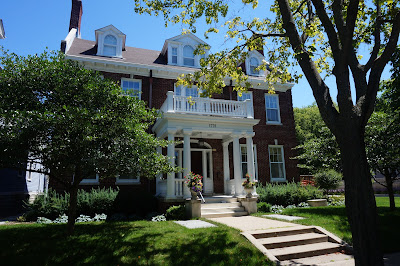Last week I decided to get to know part of the neighborhood a little better. I'd had surgery the previous week, and the chosen day promised to be the hottest in four years. This would be my shortest urban hike, ever.
I walked from our home to the 1925 Elizabeth C. Quinlan House (pictured above). Quinlan operated a successful department store in the Young-Quinlan Building, a gracious structure that still adds heart to downtown Minneapolis.
 |
| Interactive map. |
Across the street, the 1895 A. D. Arundel House tries to make a grand statement with its Classical Revival colonnade.
In the 1890's, A. D. Arundel was superintendent of the Minnesota Iron and Steel Works. Thomas Lowry, the early developer of Lowry Hill, was a major investor in the steel works.
Down the hill, two houses, now commercial spaces, bookend the mid-century modern First Unitarian Society of Minneapolis.
 |
| 1894 Frank Long House (Now Groveland Gallery). |
 |
| 1894 William Nott House (Now Kodet Architectural Group). |
Both houses were designed by the architectural firm, (Frank) Long and Kees. The firm designed many prominent Minneapolis buildings still standing today, including Minneapolis City Hall and the Lumber Exchange Building.
William Nott created his wealth manufacturing leather drive belts for the grain mills that were popping up at the time.
Across the street from these houses, The Walker Art Center dominates the skyline. I went there next in pursuit of coolness.
I chose the "Ordinary Pictures" exhibit which features art that uses stock photographs. I was pleased with my choice: the repetitive images were calm and cool.
After a pulled pork sandwich and a Surly Furious in the gallery's restaurant, I took in one more exhibition. Please be advised that the gallery that you are about to enter contains a work with explicit sexual imagery and mature content the sign warned. Just to be sure, a docent handed me a sheet of paper with a similar message.
Back outside in the heat, I started to head back towards home.
Thomas Lowry Park is a rather fine pocket park with a stream running through it. Until recently the water was piped from the Mississippi, but today the stream depends on a recirculating pump.
The park carries the name of the founder of this subdivision. In the 1890's he had the wisdom to put in a streetcar line that ran right past this park, and beckoned people to purchase housing lots.
A couple more houses and I would be back home in air conditioning.
The 1905 John Lind House was built by a former Minnesota governor. After completing his term of governor in 1900, Lind walked over to the offices of the St. Paul DIspatch and punched the managing editor in the face.
Finally, two blocks from our own home, I stopped at the 1892 Pierson-Wold House.
Theodore Wold, the second owner of this house, was the first Governor of the Ninth Federal Reserve Bank in Minneapolis. His son, Ernest, grew up here.
Wold-Chamberlain Field, better known as Minneapolis-St. Paul International Airport, honors two World War I pilots who died in action: Ernest Wold and Cyrus Chamberlain. I'll think about them next time I pass through MSP.







Wonderful to learn about my neighborhood! And, lovely photos too.
ReplyDeleteThank you. There are so many stories out there.
Delete